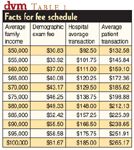Stop monkeying around with your practice fees
Use demographics and a little easy math to determine a profitable fee schedule for your veterinary practice
In the one-act play Words, Words, Words by David Ives, three monkeys named Milton, Swift and Kafka have been confined to a cage by Dr. Rosenbaum—not a veterinarian—who has this hypothesis: "Three monkeys hitting keys at random on typewriters for an infinite amount of time will almost surely produce Hamlet." Tragically, this play reminds me of the 35,000 U.S. veterinarians who play a daily guessing game called composing a fee schedule.
Randomly hitting keys
There is a never-ending supply of permutations by which our colleagues determine fees. The most popular is also usually the least financially successful: Just take the fees of another hospital and adopt them as your own. Generally, these copied fees originated with the hospital's predecessor decades ago and the logic used to create them is lost in the sands of time. Fees that are client sensitive are left to molder, and others have skyrocketed to unjustifiable levels.
Another method of determining fees is to use the American Animal Hospital Association's Veterinary Fee Reference. Here you can find what veterinarians charged yesterday; by the time the reference is published, it's out of date. The other problem is that it's an amalgam of fees, averaging Alaska fees with Alabama fees and the affluent municipalities with those at or near the poverty level, with no basis for positioning your location.
Similarly, the veterinary insurance companies can provide you with a list of fees at the 90 percentile of national allowances. Again there is no localization, but some, like Veterinary Pet Insurance (VPI), have minimum, average and higher-cost plans you can compare. For example, San Francisco veterinarians would want to use the fees in VPI's Superior plan, while those in Kentucky might use the Standard plan.
A better way
Table 1 shows goals for practices based on local demographics in which 25 years of research has shown the most comfortable and profitable exam fees based on average family income within a five-mile radius of the veterinarian's front door. These fees aren't based on a neighbor's or predecessor's fees but on U.S. 2010 Census statistics. These are not based on ZIP codes, because many ZIP codes have affluent areas and poverty level areas. Using an average in these areas would put a practice out of business.

TABLE 1 Facts for fee schedule
As a practical example, go to your favorite supermarket and note the prices of any 10 items. Then drive three to five miles to another supermarket in the same chain and price those same items. You will almost always find a 5 percent to 15 percent difference. Why? Because the store managers know their customers, and they can charge according to customers' comfort level while still maintaining profitability.
But you can be assured that two areas hundreds of miles apart with a $55,000 average family income will both support a $101.75 average hospital transaction (includes diets, boarding and other over-the-counter charges) and a $145.84 average patient transaction (the patient is presented for treatment).
If we know both the average hospital transaction in an area and the number of transactions to be expected from our share of the 60 percent of pet-owning households and the 60 percent of those households that will get veterinary care, we can project annual revenue for any hospital at any location. Then, if the expected revenue is $900,000 and we're only getting $650,000, we know the difference is likely in the management. Either the fees are off, the veterinarian needs a personality tune-up or the receptionist needs to be declawed. However, if the reverse is true, and the needs of the hospital are $900,000 to meet overhead and the market share cannot exceed $650,000, then it was a folly to put the practice there. Math is a wonderful tool and can be fun, but it can be painful as well.
Final thought
Veterinary care is a great value. The cost of veterinary care has risen little over the past 20 to 30 years, especially when compared to the cost of human healthcare. It's just a shame that most practices today cannot profit enough to support the sophisticated medical services we provide and still pay associates and support staff the compensation they need and deserve. A nationwide wake-up call about fees is needed. Until then, most practices will be subsidizing their clients and patients at the expense of their families and retirement.
The saddest—and truest—statement I've ever heard is that the only rich veterinarians you'll ever meet made their wealth from real estate.
Dr. Snyder, a well-known consultant, publishes Veterinary Productivity, a newsletter for practice productivity. He can be reached at 112 Harmon Cove Towers Secaucus, NJ 07094; (800) 292-7995; Vethelp@comcast.net; fax: (866) 908-6986.